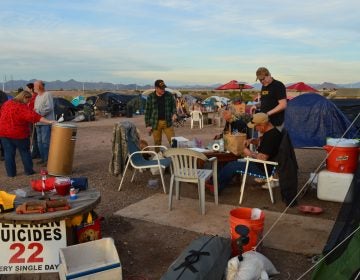Housing comes first at Philly program for homeless heroin users
Pathways to Housing Pa. uses what's called a "housing-first" approach. Its program for those with severe opioid addiction is one of the first of its kind in the country.
Listen 5:57-
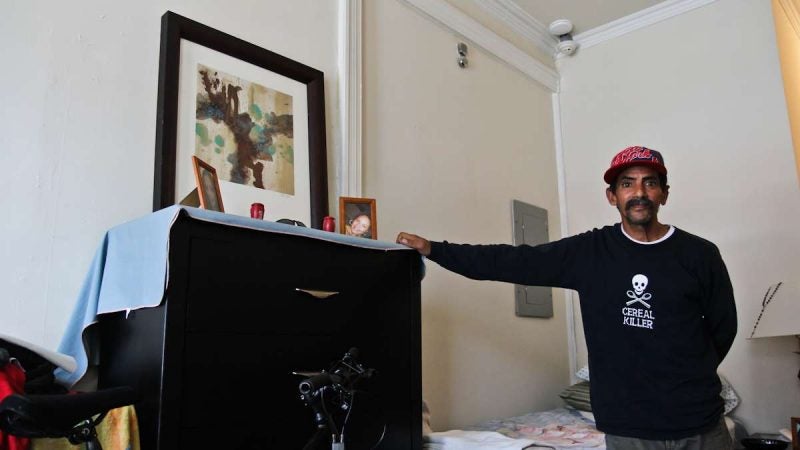
Israel Reyes, 61, recently lived on the Conrail Train tracks in Philadelphia’s Kensington neighborhood. He recieved assistance to move into a studio apartment since the clean-up began. (Kimberly Paynter/WHYY)
-
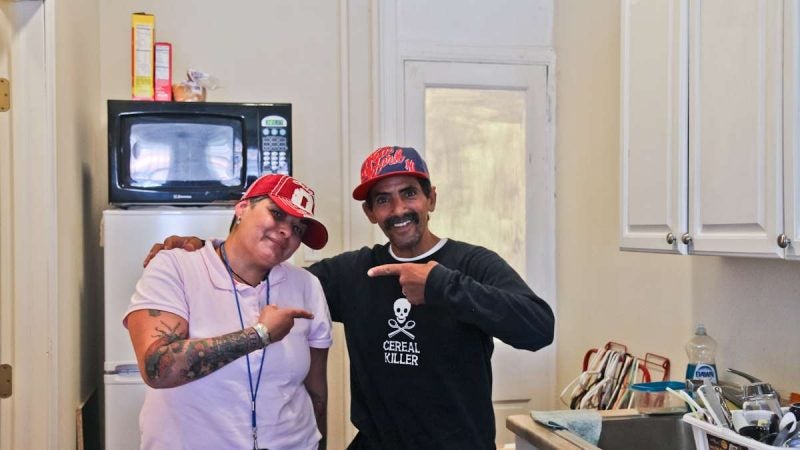
Nancy Falcon, certified peer specialist with Pathways to Housing, helped Israel Reyes into an apartment after those living on the Conrail Train tracks were forced to move in early August. (Kimberly Paynter/WHYY)
-
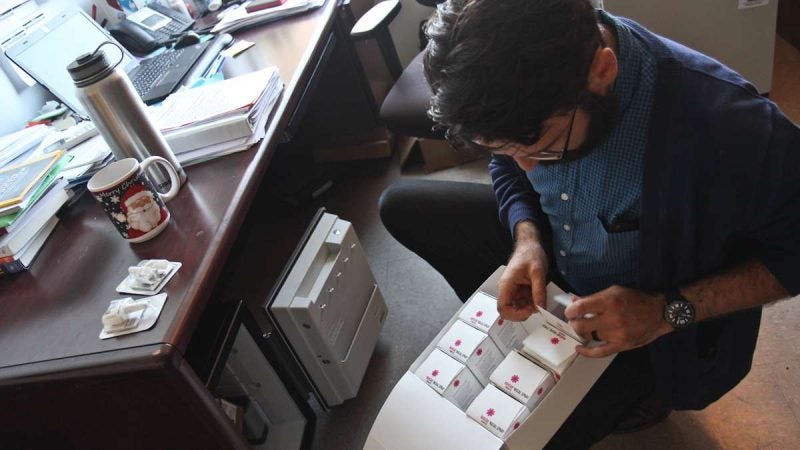
Matt Tice, Director of clinical services at Pathways to Housing, retrieves Narcan from a safe in his office. (Kimberly Paynter/WHYY)
-
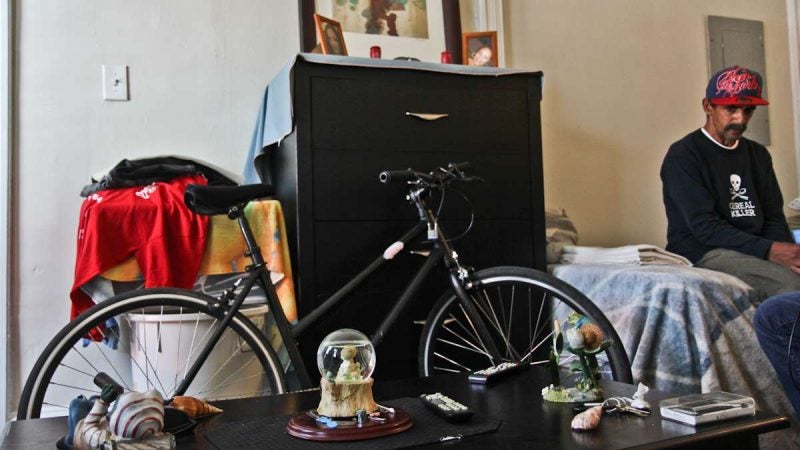
Israel Reyes, 61, recently lived on the Conrail Train tracks in Philadelphia’s Kensington neighborhood. He recieved assistance to move into a studio apartment since the clean-up began. (Kimberly Paynter/WHYY)
-

The Pathways to Housing team discusses the needs of clients at their morning meeting. (Kimberly Paynter/WHYY)
-
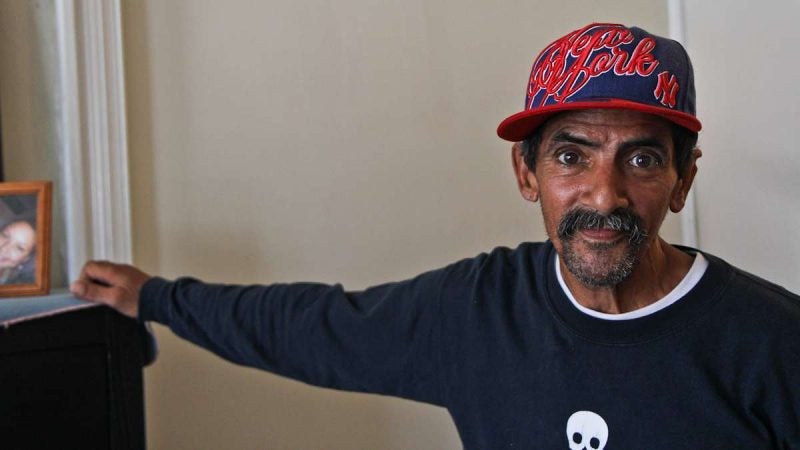
Israel Reyes, 61, recently lived on the Conrail Train tracks in Philadelphia’s Kensington neighborhood. He recieved assistance to move into a studio apartment since the clean-up began. (Kimberly Paynter/WHYY)
Just a few weeks ago, Israel Reyes was sleeping under a bridge near the notorious railroad encampment of heroin users in North Philadelphia that was known as “El Campamento.”
He lived there for two and a half years before the city and Conrail started work to clean up and seal off the tracks. When that work began, an estimated 75 to 125 drug users were living there.
“It wasn’t that pleasant,” Reyes recalled. “People trying to rob you, trying to hurt you. You know? Rats walking over you.”
Now, he has a real home. It’s an airy studio apartment in East Kensington outfitted with modern black furniture and framed pictures of his grown children.
The apartment and the furnishings were provided by the organization Pathways to Housing PA.
“They got me out of under that bridge,” Reyes said. “And I’m doing fine so far, you know?”
Reyes is in a pioneering program at Pathways that gives opioid users their own apartment, even before they get clean. Pathways uses what’s called a “housing-first” approach. Its program for those with severe opioid addiction is one of the first of its kind in the country.
“The old thinking used to be that you had to be ‘housing ready,’ you had to be clean and sober in order to earn your way into housing,” said Liz Hersh, the director of Philadelphia’s Office of Homeless Services. “And the new thinking is come as you are, just come in, and we’ll work little by little to get you where you need to go.”
The city is funding 17 new housing-first units as part of its plan to seal off the Conrail tracks where Reyes used to sleep. The cleanup has made even more obvious the enormous need for housing among people addicted to opioids in the Kensington neighborhood. The city began stepping up efforts in May to provide them treatment and shelter in advance of the plan to raze “El Campamento” and fence the rail corridor, which drove drug users into other parts of the neighborhood.
The city counts between 200 and 300 people who are homeless on the streets of Kensington, Hersh said, and that the homeless population has grown citywide in the past two years. “It appears that the opioid crisis has — is the main driver behind the growth in numbers on the street that we’ve seen,” she said.
With the new units, the Pathways program will serve a total of 75 people.
Team approach
The Pathways team gathers around a conference table every morning at their office off of North Broad Street. The team includes a psychiatrist, substance abuse specialists, a peer mentor, and several case workers.
At one recent meeting, the mention of each client triggered a cascade of updates from a dozen team members seated around the table. They discussed how to handle the challenges of assisting active heroin users — missed appointments for treatment; meetings with public defenders; clients who dodge the Pathways staff when they try to visit. Most of them are still using drugs, and some have ended up in jail.
The team is ready to connect participants to doctors, therapists, and treatment providers. But they aren’t required to accept any help. The only condition that comes with the apartment is to agree to regular meetings with Pathways’ case workers, who try to help them move toward a healthier lifestyle.
The Pathways program represents a new direction for a housing-first initiative, according to Dennis Culhane, a professor of social policy at the University of Pennsylvania whose research focuses on homelessness and supportive housing.
“A lot of the housing-first programs initially focused on people who have severe mental disorders,” Culhane said. “They’ve less frequently targeted people who are dealing primarily with a substance-use disorder.”
Research on housing first shows that these programs succeed in keeping people in their homes, he said. Studies have found that 80 to 85 percent of participants are still living there after two years. But the results relating to substance use are inconclusive.
“There’s not any real strong evidence that the housing placement is leading to recovery,” Culhane said. He and other experts said there hasn’t been enough research on housing-first programs for those with substance-use disorders to know whether it’s a reliable route to recovery.
So far, Pathways has found 42 percent of its opioid team clients are in treatment or otherwise staying clean. None of them has wound up back on the streets since the program launched last fall.
Next step: Treatment
Many of Pathways’ clients who haven’t started treatment say they are interested in it.
Israel Reyes is one of them, but the staff is having a hard time getting a solid commitment from him. Sitting in his apartment with caseworker Nancy Falcon, Reyes said he wanted to start the medication Suboxone, which helps deal with cravings and withdrawal. Then he dropped some surprising news on Falcon — he’s already been taking Suboxone.
This threw Falcon for a loop. “Really?” she said. “I’m confused.”
The treatment doesn’t seem to be working very well, Reyes said, since he still uses heroin sometimes. Reyes and Falcon agreed to go to an intake center that afternoon to find out what other options he has.
There isn’t always a straight line to treatment for Pathways’ clients. But getting totally off of drugs isn’t necessarily the goal. Housing first is considered a harm-reduction approach; its first priority is not sobriety but to reduce the dual harms of street life and severe addiction. That makes it controversial with those who favor a traditional approach that starts with abstinence.
Limited resources
The program isn’t right for everyone, said Matt Tice, Pathways clinical director.
“We tend to see the people who have the most severe need,” Tice said. “Or who are the most vulnerable.”
The Pathways program is just one intervention on what Hersh calls a “menu of options” that the city uses to help homeless opioid users. A 30-bed shelter at Prevention Point Philadelphia has been a way station for many of those who came from the Conrail tracks. The menu also includes inpatient residential treatment and other housing programs that work more gradually toward a permanent home. Over the past year, the city has put 112 people who were homeless in Kensington into long-term housing.
But, Hersh said, the city doesn’t have enough slots to help everyone.
“We are a resource-constrained system,” Hersh said. “I think of it as a firehose problem trying to funnel into a drinking straw-sized system.”
As the effects of the opioid crisis worsen in places like Kensington, that system is being put to the test.
WHYY is your source for fact-based, in-depth journalism and information. As a nonprofit organization, we rely on financial support from readers like you. Please give today.




